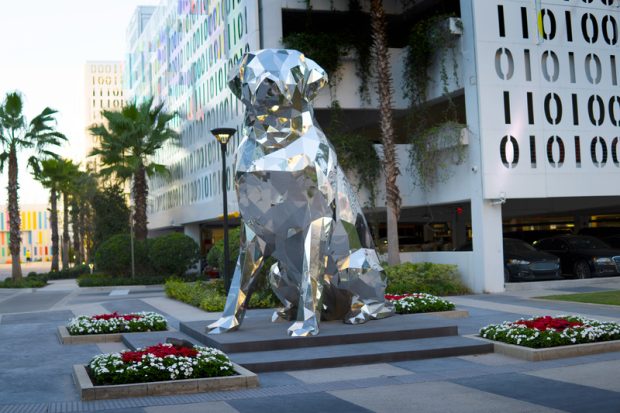
For hundreds and hundreds of years, we’ve known that dogs can find things. Hunting dogs find game. Terriers find vermin. Hounds have tracked bad guys. Dogs locate truffles.
But if anyone had suggested even thirty years ago that dogs would be trained to sniff out disease, bugs, bacteria, electronics, whale scat, stress – even molecules – it would have been thought to be the stuff of science fiction.
We’re more educated than we used to be about the acuity of of a dog’s nose. We know that all of the aforementioned objects are molecular, and thus, many (but not all) have an odor. Different molecules have different shapes and chemical properties that affect the way they interact with our olfactory receptors. Some molecules are able to bind to specific receptors in the nose, triggering a neural response that is interpreted by the brain as a particular odor. That is why different molecules can have different smells.
Not all molecules have a detectable smell, however. Some molecules are odorless to us because they don’t interact with a human’s olfactory receptors in a way that triggers a neural response. Some molecules have such a weak smell that we can’t easily detect it. When we can, it’s because our sense of smell is triggered by detecting molecules by specialized cells in our nose. When we smell something, we’re really detecting the odorant molecules that are released into the air by the source of the smell.
Dogs, however, are smelling machines. They have about forty times more smell-sensitive receptors than we do, ranging from about 125 million to nearly 300 million in some breeds. It stands to reason that they can smell what we can’t, and at the risk of oversimplifying the topic, if it has molecules, a dog can smell it.
But a rock?
In 2015, a Springer Spaniel named “Rosie” found a diamond worth $19,000. A London-based diamond retailer, 77 Diamonds, quite literally launched a PR stunt when it shot a 1.14 carat diamond into space the year before. The diamond had been attached to a helium balloon that was meant to pop when it reached a certain height and fall back to earth, the idea being that the diamond retailer would give the diamond to anyone who found it. The box containing the gem also held a GPS unit to trace it, but the unit stopped working soon after it started descending back to land. The GPS signal was lost, and so was the diamond.
Enter Rosie. She was out for a walk with her master in Brattleby, Lincolnshire, when she picked up a scent under a bush and pulled out the container holding the diamond. You can read the rest of the story here. We share Rosie’s story to introduce the notion of a dog sniffing out a mineral. Is it really possible?
Rosie probably detected odors associated with the people who had handled the box and GPS unit, and perhaps the chemicals of the weather balloon, but the idea of a rock/mineral sniffing dog is not outlandish for this reason: A dog can be trained to detect the unique odor of a particular mineral associated with certain deposits like a diamond, minerals like kimberlite and lamproite which have a distinct odor and can indicate the presence of diamonds. And while diamonds are made up of carbon atoms arranged in a crystalline structure, diamonds can absorb and trap small amounts of odorous gases or liquids on their surface which may result in a temporary smell when sniffed up close. It’s possible that is also what Rosie smelled.
But the idea of dogs using to detect a mineral predated Rosie. In the 1960s and 70s, Sweden, Russia and Finland used “ore dogs” to search for nickel for the steel industry. In a competition designed to evaluate if dogs would be better prospectors than people, one dog found 1330 sulfur boulders under the ground, while a miner could only find 270 traces above the ground. Unfortunately, the financial straits of the early 80s saw many businesses go under, including the metal and steel industry. Exploration was abandoned, and so was the practice using dogs to find the ores.
One Swedish geologist, Peter Bergman, remembered the ore dogs and started experimenting to see if dogs could really do it in a predictable way. He found that dogs could be trained to find all sorts of sulphide ore, whether it was zinc, copper or nickel, as well as oxide ore. He formed the company, OreDog, and in a 2012 interview, he not only shared the discovery of a large deposit of arsenian pyrite, a gold ore, by a dog, but that his own German Shepherd Dog, “Rex,” could search for Kimberlite, the mineral we mentioned earlier. When Rex detected it, he barked and whined as he dug at the ground. Bergman had plans to turn the canine skills into a multi-million dollar global industry providing exploration services for the mining industry, and had three fully trained dogs “on staff,” including an Australian working Koolie and a Malinois.
We suspect it didn’t work out that way. OreDog’s Facebook page hasn’t been active since 2018 (though the photographs make it worth a visit). Nor does there seem to be an active website. Still, it’s an interesting concept and perhaps one day, someone else will run with it.
Image: Diamond Dog created by Filipino American artist, Jefre; photo by © Creativestudio79 | Dreamstime is a sculpture found in Lake Nona Town Center, Florida
